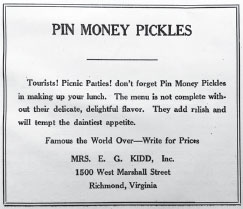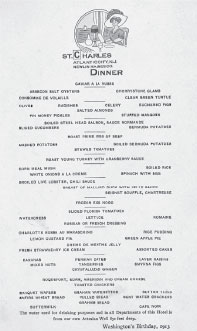
Pin Money Pickle factory at 1500 Marshall Street. The Valentine.
HOMEMADE SUCCESS
Pin Money Pickles and Suffrage
You know you’ve made it big when a bank in your hometown uses your success story to woo customers, implying that they may make it as big as you did with your Pin Money Pickle recipe.
That’s exactly what American National Bank did in November 1919.
By that time, Ellen G. Tompkins Kidd was running a pickle processing plant at 1500 West Marshall Street that produced one thousand barrels a day—a long way from mixing up batches of the family’s recipe for gherkins at home and selling them to make a little extra “pin” money.104
In 1868, sixteen-year-old Ellen was making pickles in her parents’ home from her great-grandmother’s recipe, selling them to friends and winning prizes at the state fair. Four years later, she still was selling her pickles from the basement of her 619 North Sixth Street home with the encouragement of her lawyer husband, John Boulware Kidd, when an order came in from Seattle, Washington, for five barrels (or 150 gallons of pickles). She thought it was a mistake and sent the customer five gallons. She received a telegram: “Barrels, barrels, five. Could eat five gallons by myself.”105
Kidd traveled to Chicago in 1873 to visit a friend, and during that trip, she met two men from the Pullman Company, Major Dangerfield and Captain Angel, who changed the course of her business. “I remembered them because of the angel and the danger. I think I took them by surprise, because I was younger then, and very much dressed up, and when they refused to see the samples which I had carried along, I plead that I had never been on a Pullman car, and that I should like to go on one. Well, they couldn’t very well refuse me that. When we went into the diner, they let me taste some of their pickles, which were in a delightful state of fermentation, but of course I said nothing about that. After I had somehow eaten the pickle, I said, ‘Now I’ve tried yours, won’t you try mine?’ Well, of course they couldn’t very well refuse me that, either.” By the time Kidd returned to Richmond, she had an $800 order for Pullman passenger railway dining cars, which in turn exposed her product throughout the country.106

Pin Money Pickle factory at 1500 Marshall Street. The Valentine.

A 1920 ad from the Virginia Cookery cookbook produced by the Virginia League of Women Voters. Susan Winiecki.
IN A PICKLE
That Pullman order and others meant literally getting herself out of a pickle when it came to her supply chain, so Kidd reached out to family member William Taliaferro in Essex County to help her grow enough burr gherkins (a wild cucumber originally from the West Indies) to meet increasing demand. He organized farmers in Essex and four surrounding counties to plant acres of gherkins. When the cucumbers were ready for harvest, he set up pickle-brining stations in strategic locations so that ripe pickles could be preserved on their way to Richmond.107
In 1898, her family—Ellen and John had four children together—moved to 706 East Leigh Street, where her pickle “kitchen”/plant was built in back of her house. By 1910, she had moved her “kitchen” to a new five- story plant on Marshall Street. Kidd, a masterful marketer, took out a half-page ad in the March 20 Times-Dispatch to tell her own story, which included a drawing of her Leigh Street house and “kitchen” with the headline: “The Phenomenal Growth of an Unusual Enterprise.” She included a customer fan letter and a coupon for a free sample jar. Pin Money Pickles also were appearing in hotels across America and in Europe—from the Plaza in New York City to the Hotel Chamberlin in Virginia—each hotel bound to use the trademarked name on its menu. They were even served at the White House.108

Pin Money Pickles were on the menu of the St. Charles Hotel as well as the Jefferson in Richmond and the Plaza in New York. New York Public Library.
“The public likes the homemade product,” Kidd said, “and you can maintain the homemade standards in the factory as well as in the home.”109
Her supportive husband passed away in 1910, and she sold her Leigh Street house and moved into the Shenandoah apartments on Allen Avenue—one of her many real estate investments. She incorporated as Mrs. E.G. Kidd, Inc., and her company became a Richmond Chamber of Commerce member in the fall of 1913.
WOMEN’S WORK
In 1909, a small group of Richmond women formed the Equal Suffrage League of Virginia. Attending rallies in Capitol Square and elsewhere, Kidd and the league worked to obtain the women’s vote until three-fourths of the state legislatures (but not Virginia’s) ratified the Nineteenth Amendment in 1920. The suffrage league then disbanded and formed the Virginia League of Women Voters, of which she was a charter member and treasurer.110
By 1927, she had sold her controlling interest in the company, retiring to the Shenandoah. The company continued production in Richmond until 1950.111
Kidd, who died in 1932, was the only female member of the Richmond Chamber of Commerce for years, and she also served on the board of Sheltering Arms Hospital for more than twenty years.112
Of her early zeal for promoting her product, both in person and through the mail, Kidd said, “I think I must have been the original woman drummer.” Only she used pickles as her drumsticks.113